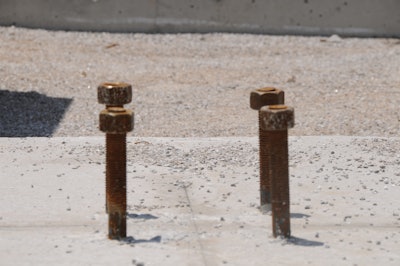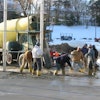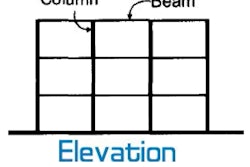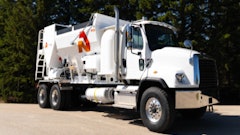
Who do you talk to when you have questions related to your business? And how much help do you get? Well, if you were a member of the American Society of Concrete Contractors (ASCC) you’d have about 500 buddies to talk to. How? The ASCC Contractor E-mail Forum allows contractor members to submit business and technical questions via e-mail. A question by one contractor can elicit many helpful responses. A members-only, web-based Concrete Information Directory also contains all of the Q&A’s from the Forum for easy long-term reference. We’ve decided to share an especially good question and the responses from our members. This can help all contractors with these types of problems.
Question: We’re constructing a manufactured metal building that has 25 sets of anchor bolts. According to the drawings, all bolts are the same diameter and length. Anchor bolts are supplied by the General Contractor (GC) and we're required to install them. After installing approximately half of the bolts it was discovered that the bolts are too short. The required embedment depth is deeper than the anchor bolt length allows for.
The General Contractor is now back charging us, claiming we are responsible for checking embedment depth. Normally we are only concerned with projection of bolts, thus we don't check embedment depth or anchor bolt length, especially when all the bolts are the same size.
Do I have any recourse for the back charge? What's my defense?
Responses:
- “GC is trying to screw you. GC supplies, you install what they provide typically, at least in our area."
- "If you're working off an approved set of anchor bold drawings, that should free your from responsibility."
- “We install GC supplied bolts all the time on our projects. If the bolts are too short it is a given that the GC project engineer or purchasing agent screwed up. We would usually have a stamped plan for the building to OK everything. We, on the other hand, check for depth of bolt because some of the projects require bolts to be embedded from in the footing to X amount projected out of top of wall or pilaster. So I would say in my world this would be a shared fix if the wall is cast already. If it is not, that would be an easy fix. They get the correct bolts and depending on how much you like this GC you would back charge them for the replacement or work with them on the replacement. Either way this will cost both parties. Every project is a team effort and partnership. If in this case they try to unload the total cost on you they don't sound like a GC I would work for anymore.”
- “Are the footing designed for uplift or gravity loading? I would most likely look to see if the in-place capacity of the bolts will work before I did anything else? I may then try to get the engineer to allow us to drill the base plate/footing and add epoxy anchored bolts to compensate. Does your contract require you to receive plus verify quantity and size/length of bolts?”
- “We are not an engineer or designer, we are a concrete contractor who installs per plans and specs for what is supplied to us. In your case, I would argue that this is an error on the part of the metal building designer or the engineer on the project, as well as the General Contractor's superintendent for "missing it" and taking the wrong product on site. You should be paid for the initial installation as well as the repairs as it was not your mistake at all. Just my opinion. I don't know what your contract states, but I think you have a good argument for mediation if the GC wants to pursue the back charge.”
- “We have had the opposite issue, where the anchor bolts shown on the structural drawings are too long, and would end up below the footing subgrade! Suggest that you discuss with your client and architect/engineer; as noted elsewhere, the ‘reduced’ embedment may be just fine as is. The architect/engineer may have to sharpen their pencil on this. IMHO you are faultless. You are not QA/QC for the entire project. You probably are asked to ‘receive, inventory and install...’...from ‘approved shop drawings’...and that is that. Note that if this is a metal building (e.g., Pre-Engineered like a Butler or Nucor), the anchor bolt plan you are usually given does not have an embedment dimension; they usually only have a dimension from the bottom of the plate to the top of the bolt, since it is not a part of their standard scope. Determination of embedment is the responsibility of the A/E in responsible charge.”
- “Unfortunately there is not a lot you can do with a client who wants to be unreasonable. I would, however, look into whether or not your employees signed for the bolts when they were delivered. Often, on the receipt from vendors supplying these types of items, the fine print will have the signer agree the items were correct and in good condition when they were signed for. If the GC signed for the bolts and you can verify this language on the delivery ticket, you have your defense.”
- “I was snookered with anchor bolt placement in the early 1990s and ever since then I have stated in my line items, and clearly state in my contract, that we will not be responsible for placement of anchor bolts...ever. We are not building the building — they are. We are only pouring the concrete. Let them take responsibility for their building, and we take responsibility for our concrete, reinforcing, and placement. I remember arguing with one GC about this and I stayed fast to "I will not set them, but I will assist with placement with your layout man" and he finally gave in and had his best man lay them out and place them for 53 foundations. When all was said and done his man had to cut off and drill and epoxy 20 misplaced bolts — and this was his top man.”
- “There have been quite a few helpful responses to the issue, but I believe there is a need for further clarification to fully understand and assist in the appropriate position for you to take:
1. You state the drawings call for the same size anchor bolts at every location. Which drawings are these, the contract structural/pre-engineered building drawings, the anchor bolt drawings or some other drawings?
2. How was it ultimately determined that the embedment length is not sufficient? If, for example, the approved drawings identify 16-inch bolts with a 6-inch projection, the embedment would be 10-inch You can't provide more embedment and projection than the bolts allow for. Even if there is information that identifies a need for more combined projection and embedment than the designed and approved bolts allow for, it would be an extreme stretch for you to be blamed. You may have been able to save the day by pointing it out if you actually noticed this, if the information was shown, but you can't be penalized for not identifying it.
If you installed the bolts to the proper projection and they were the correct length bolts per the information you had at time of installation, I have a hard time understanding how anyone could penalize you. Maybe with some more clarification on the information above, we can provide more feedback.
I also wouldn't install any more bolts until you've received clear written direction from the GC and architect/engineer on how to proceed.”
J. “As a Concrete Subcontractor we are interested in the location and projection of the anchor bolts. This is a matter of the anchor bolts being ‘Specified by others’ – ‘Submitted by others’ – ‘Approved by others’ - ‘Supplied by others’ - ‘Delivered by others’ and more than likely unloaded by others, then pointed at by the GC who says ‘there are your anchor bolts’. The unfortunate part is not whether you are right or wrong it’s how long can you go without your money.
1. Were there shop drawings submitted and approved for the project?
2. Were you supplied with the approved shop drawings?
3. Does the length of anchor bolts on the shop drawings coincide with the length on the structural plan?
4. Does your contract language state anything in regard to ‘verification, examination, or confirmation’ of the anchor bolts supplied by others?”
Did the responses adequately answer the contractor’s question? It’s hard to tell. However, a number of the responses will assist the contractor in evaluating whether he has a defense and whether he should argue against the back charge.
The ASCC Email Forum is used by ASCC members to discuss technical issues and to ask questions about business and professional issues as well. Other recent topics have included safety issues when working with wire mesh in slabs, aesthetic issues related to discoloration related to curing, polished toppings, communication planning for jobsite accidents, and lifespan for pervious concrete.









![Fcp Racatac Chair 10893876[1]](https://img.forconstructionpros.com/mindful/acbm/workspaces/default/uploads/2025/10/fcp-racatac-chair-108938761.10l0At5WXv.png?ar=16%3A9&auto=format%2Ccompress&bg=fff&fill-color=fff&fit=fill&h=135&q=70&w=240)








